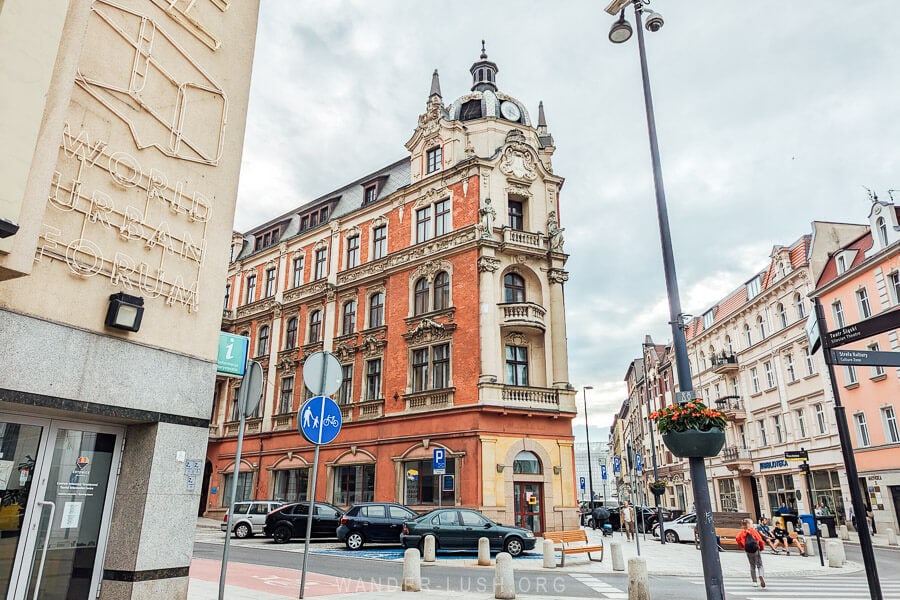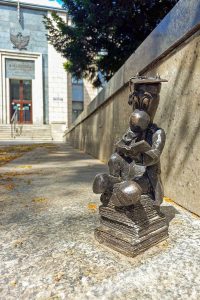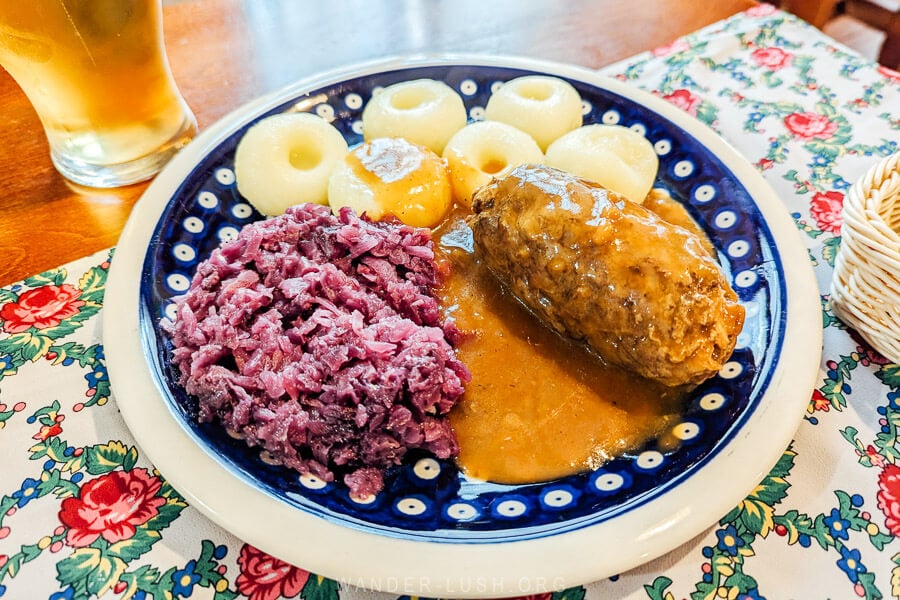Katowice gained prominence for its coal mining heritage, flourishing in the early 1800s. As fossil fuels and traditional industries wane, the city has repurposed its industrial remnants into art galleries, cozy cafes, and vibrant cultural venues. Its architectural landscape is a captivating blend of modernist designs, brutalist structures, and historic red-brick tenements and worker dwellings. Additionally, the cityscape is punctuated by remnants of communist-era sculptures and housing blocks. Katowice exudes resilience and an enduring spirit of autonomy, manifesting in intriguing ways even today.

Source: https://wander-lush.org/things-to-do-in-katowice-poland/
Silesian Museum
The Silesian Museum complex seamlessly blends restored heritage brick structures with cutting-edge glass cubes. It encompasses multiple museums, event venues, a restaurant, and a souvenir shop. The primary display area is nestled underground within the former mining shaft, offering a memorable descent into the heart of the facility. Admission grants access to various galleries, with the standout being a comprehensive, immersive journey through the history of Upper Silesia. This narrative spans the region’s ties with Germany, its industrial evolution, the communist era, and the subsequent uprisings. The experience begins with a meticulously recreated miners’ changing room, complete with suspended work attire. The adjacent displays featuring post-war Polish art and religious artifacts are equally compelling.

Source: https://wander-lush.org/things-to-do-in-katowice-poland/
Spodek
Located a brief 10-minute stroll from the Silesian Museum, the Spodek Arena stands as a cornerstone of the Katowice Cultural Zone, alongside the National Polish Radio Symphony Orchestra. The Spodek’s design evokes a spacecraft, its tilted angle hinting at an imminent launch.
The Spodek seamlessly merges futuristic aesthetics with nostalgic charm. A closer look reveals intricate stone mosaics adorning some of its outer bands. For an elevated perspective, ascend the zigzagging stairs to the grass-covered roof of the Katowice International Conference Centre. At its pinnacle, a sheltered terrace awaits, offering a unique vantage point of the Spodek, framed by its distinctive angular silhouette. During the summer, the eastern base of the Spodek transforms into a lively pop-up bar area, featuring stalls peddling cold beers, cocktails, and appetizers. Deck chairs dot the area, accompanied by music playing from overhead speakers. The ambiance at sunset is simply enchanting – a quintessential Katowice experience not to be missed.

Source: https://wander-lush.org/things-to-do-in-katowice-poland/
Market Square and Mariacka Street
Katowice’s main square sprawls as a vast pedestrian expanse intersected by tram lines, comprising three distinct squares: Kwiatowy, Teatralny, and Obroncow Katowic. The square shines with Modernist gems dating back to the communist era. Notable landmarks from this period include the Zenit Cooperative Department Store (1962), distinguished by its concrete brise soleil, and the Skarbek Cooperative Department Store (1975), featuring a striking blue-and-white facade and external elevators.
Other architectural highlights around the square include the Romanesque Silesian Theatre (1907) on its northern edge and the neo-Renaissance Hotel Grand from the 1920s. Amidst the diverse apartment buildings and preserved tenements, such as the captivating Secessionist house from 1903 adorned with walnut trees across from the Skarbek store, stands the Monument to the September Scouts (Pomnik Harcerzy Wrzesnia), commemorating those who defended the city against German forces in 1939.
Connecting to the Market Square from the east, Mariacka Street offers a bustling dining scene, teeming with international eateries, sidewalk cafes, and bars. At the street’s opposite terminus, the neo-Gothic Church of the Immaculate Conception of the Blessed Virgin Mary beckons for a visit.

Source: https://wander-lush.org/things-to-do-in-katowice-poland/
The Silesian Insurgents’ Monument (Pomnik Powstancow Slaskich)
The trio of Silesian Uprisings, spanning from August 1919 to July 1921, is etched deeply into the fabric of Katowice’s identity and the spirit of its inhabitants. Rooted in the residents’ aspiration to secede from the Weimar Republic and unite with the Polish Republic, these uprisings achieved partial success. The Silesian Insurgents’ Monument (Pomnik Powstańców Śląskich) stands as a potent symbol of Polish nationalism, striking in its monumental scale and artistic form.
Crafted by sculptor Gustaw Zemła and architect Wojciech Zabłocki, this masterpiece was unveiled in 1967 on the periphery of a small elevated park, commanding a panoramic view of Katowice Rondo. The sculpture’s three imposing wings symbolize the triad of uprisings, while its expansive concrete terrace invites visitors to traverse its inner sanctum. The monument’s base, accessible via a ramp, bears inscriptions of the cities and towns across Silesia where these historic rebellions transpired.

Source: https://wander-lush.org/things-to-do-in-katowice-poland/
Nikiszowiec
Located 7 kilometers east of Market Square, Nikiszowiec stands as a purpose-built suburb of Katowice, established in 1908 to accommodate workers from the Wieczorek Mine and their families. Serving as a living museum brimming with captivating architecture, Nikiszowiec offers an insightful glimpse into the rich history of the entire Silesian region.
Navigating Nikiszowiec on foot is a breeze due to its compact size. The suburb is essentially bifurcated into a commercial zone, housing markets and shops, and a residential area. The multi-tiered brick residences, featuring communal courtyards known as ‘familoki’, sport red accents, echoing the architectural style found in mining communities across Europe, including the UK. Take note of the tools etched onto some facades, a practical touch ensuring weary miners could easily identify their homes after long shifts.
Nikiszowiec’s charm is undeniably picturesque, making it a favorite spot for Instagram enthusiasts. However, it’s essential to be respectful when photographing, as this vibrant community remains home to many families. In recent years, gentrification has breathed new life into the area, leading to the emergence of quaint cafes, souvenir shops, and galleries in formerly vacant spaces. Don’t miss “Śląska Prohibicja”, a restaurant housed in the historic miners’ refectory, offering a culinary experience not to be missed.

Source: https://wander-lush.org/things-to-do-in-katowice-poland/
Wilson Shaft Gallery
he Wilson Shaft Gallery, conveniently situated within walking distance from Nikiszowiec, offers a seamless extension to your exploration after concluding the walking tour. True to its name, this contemporary gallery occupies a repurposed mine shaft.
Spanning two expansive, airy galleries, the space showcases modern paintings along its periphery, sculptures on the main floor, and installations nestled within a labyrinth of interconnected chambers and rooms. With a staggering total floorspace exceeding 2,000 m2, it proudly holds the title of Poland’s largest private gallery.
Guided by the ethos, “What industry took away, culture must regain,” the Wilson Shaft Gallery exemplifies Katowice’s knack for breathing new life into disused spaces. It stands as a testament to the city’s commitment to reclaiming and redefining its identity, ultimately returning these transformed venues to the community.

Source: https://wander-lush.org/things-to-do-in-katowice-poland/
Search for Beboks
While gnomes reign supreme in Wroclaw, Beboks hold a special place in the heart of Katowice. Stemming from Silesian folklore, these mischievous figures are sprinkled throughout the city, adding a touch of whimsy to its streets. Every child in Upper Silesia grows up hearing tales of Beboks, often invoked by parents or grandparents as playful warnings akin to the ‘bogeyman’.
Local artist Grzegorz Chudy is the creative force behind the modern incarnation of Beboks, infusing this mythical entity with a diverse array of forms and personalities. Embark on a Bebok scavenger hunt across Katowice and try to spot as many as you can. Each Bebok boasts a unique appearance and character, making each discovery a delightful surprise. While some may be pinpointed on Google Maps, don’t let that detract from the excitement of the chase!

Feast on Silesian Cuisine
Silesian cuisine is a culinary delight that tantalizes the taste buds with its rich flavors and hearty dishes. One cannot talk about Silesian gastronomy without mentioning rolady and pierogi.
Rolady are thinly sliced cuts of beef or pork wrapped around a savory filling of bacon, onions, and pickles. Slow-cooked to perfection, these rolls burst with a harmonious blend of flavors, making them a beloved comfort food that warms the soul.
Pierogi, on the other hand, are versatile dumplings that come with a variety of fillings, both savory and sweet. In Silesia, you’ll find pierogi filled with potato and cheese, meat, or mushrooms, each offering a delightful burst of flavors in every bite. Whether boiled or pan-fried, these dumplings are a quintessential part of Polish cuisine, and the Silesian version is no exception.
So, if you find yourself in Katowice do not miss the opportunity to savor these iconic dishes. They are a true testament to the region’s culinary heritage and are sure to leave you craving for more!

Source: https://wander-lush.org/things-to-do-in-katowice-poland/
